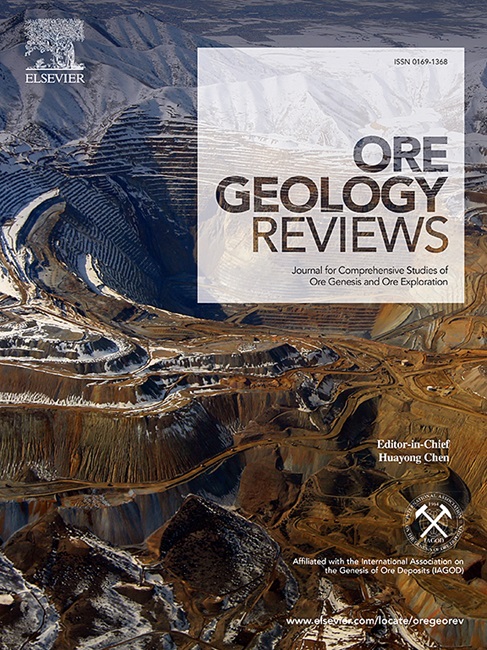Formation of the Miocene Weixi Sb-polymetallic mineralization in the Sanjiang Region, SW China: Insights from fluid inclusions, S-He-Ar isotopes, and zircon U-Pb geochronology
IF 3.2
2区 地球科学
Q1 GEOLOGY
引用次数: 0
Abstract
The Weixi Sb-polymetallic orefield (>0.2 Mt Sb) in the Sanjiang metallogenic belt (northwestern Yunnan, SW China), represents a distinct type of Sb-polymetallic mineralization. Here, we examine the ore-fluid properties, source, and metallogenic process by analyzing the fluid inclusions, S-He-Ar isotopes, and zircon U-Pb age of three representative deposits (Shangnuluo, Baiji, and Hagudi) in the orefield. Early pyrite-molybdenite mineralizing fluids in the Baiji deposit contain A-type (liquid H2O), B-type (gaseous CO2), C-type (H2O-CO2), and D-type (solid-bearing) inclusions, showing a CO2-rich, high-salinity (30.6–36 wt% NaCleqv.) fluid at medium–high temperatures (177–442°C), with metal precipitation primarily driven by fluid boiling. In the late sphalerite-galena-zinckenite-stibnite-calcite-quartz stage (Baiji), A-, B-, and C-type inclusions indicate lower temperatures (186–276.6°C) and salinity (0.35–12.4 wt% NaCleqv.), where metal deposition is controlled by fluid mixing. The Hagudi ore fluids are of medium–low temperature (150–368°C) and salinity (3.2–21.2 wt% NaCleqv.), contain primarily A-type (with some B-type) inclusions, with cooling and mixing being the main ore-forming mechanism. The Shangnuluo ore fluids are of medium temperature and low salinity, contain mainly A-, B-, and C-type inclusions (NaCl-H2O-CO2 fluid system), with immiscibility driving the metal precipitation. These fluid characteristics resemble typical orogenic or magmatic-hydrothermal ore fluids rather than basin-type ore fluids. He-Ar isotopes suggest a primarily crustal fluid origin with minimal mantle contribution. In-situ sulfur isotopes (Shangnuluo: −13.04 to −2.90 ‰; Baiji: −1.60 to 6.65 ‰; Hagudi: −2.48 to − 1.54 ‰) imply a magmatic and Permian formation source at Shangnuluo, magmatic and Jurassic formation source at Baiji, and a primarily magmatic source at Hagudi. Zircon U-Pb dating places the formation of ore-hosting quartz porphyry at Hagudi in the Late Permian (252.7 ± 2.4 Ma). The quartz porphyry was formed before the Miocene mineralization event (∼13 Ma) and potentially provided ore-hosting space for the Miocene mineralization.
Integrating our new data with previous studies on regional tectonics and magmatism, we speculate that the Weixi Sb-polymetallic mineralization is closely linked to concealed Miocene crustal magmatism. Ore-forming fluids migrated along faults into various stratigraphic levels, and metal precipitation was triggered by fluid immiscibility, cooling, and dilution by formation or meteoric water.

求助全文
约1分钟内获得全文
求助全文
来源期刊

Ore Geology Reviews
地学-地质学
CiteScore
6.50
自引率
27.30%
发文量
546
审稿时长
22.9 weeks
期刊介绍:
Ore Geology Reviews aims to familiarize all earth scientists with recent advances in a number of interconnected disciplines related to the study of, and search for, ore deposits. The reviews range from brief to longer contributions, but the journal preferentially publishes manuscripts that fill the niche between the commonly shorter journal articles and the comprehensive book coverages, and thus has a special appeal to many authors and readers.
 求助内容:
求助内容: 应助结果提醒方式:
应助结果提醒方式:


